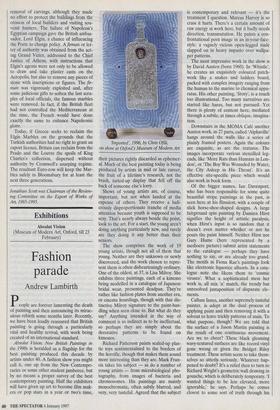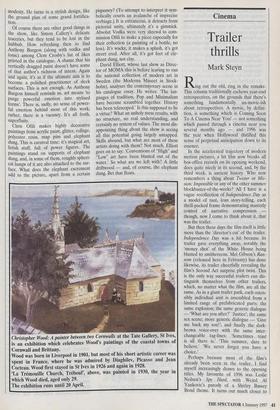Exhibitions
Absolut Vision (Museum of Modern Art, Oxford, till 23 February)
Fashion parade
Andrew Lambirth
People are forever lamenting the death of painting and then announcing its mirac- ulous rebirth some months later. Recently, we have been loudly reassured that British painting is going through a particularly vital and healthy revival, with work being created of an international standard.
Absolut Vision: New British Paintings in the 1990s is heralded as a flagship for the best painting produced this decade by artists under 40. A fashion show you might call it, one up from the New Contempo- raries or some other student jamboree, but by no means a proper survey of the best contemporary painting. Half the exhibitors will have given up art to become film mak- ers or pop stars in a year or two's time, Imported, 1996, by Chris Ofili, on show at Oxford's Museum of Modern Art their pictures rightly discarded as ephemer- al. Much of the best painting today is being produced by artists in mid or late career, the fruit of a lifetime's research, not the brash, tarted-up display that fell off the back of someone else's lorry.
Shows of young artists are, of course, important, but not when lauded at the expense of others. They receive a ludi- crously disproportionate tranche of media attention because youth is supposed to be sexy. That's nearly always beside the point, look to the art. For a start, the young aren't doing anything particularly new, and rarely are they doing it any better than their seniors.
The show comprises the work of 19 young artists, though not all of them that young. Neither are they unknown or newly discovered, and the work chosen to repre- sent them is often dishearteningly ordinary. One of the oldest, at 37, is Lisa Milroy. She exhibits three paintings, each of a kimono being modelled in a catalogue of Japanese bridal wear, presented deadpan. They're rather like fashion plates from another era, or cinema hoardings, though with that dis- tinctive Milroy signature to the paint-han- dling when seen close to. But what do they say? Anything intended in the way of comment is so indirect as to be ineffectual, so perhaps they are simply about the decorative patterns to be found on kimonos.
Richard Patterson paints scaled-up plas- tic toys sentimentalised to the borders of the horrific, though that makes them sound more interesting than they are. Mark Fran- cis takes his subject — as do a number of young artists — from microbiological pho- tography, from images of bacteria and chromosomes. His paintings are mainly monochromatic, often subtly blurred, and very, very tasteful. Agreed that the subject is contemporary and relevant — it's the treatment I question. Marcus Harvey is so crass it hurts. There's a certain amount of raw energy at work here, but it badly needs direction, transmutation. He paints a con- frontational porn image in an in-your-face- style: a vaguely vicious open-legged nude slapped on in heavy impasto over wallpa- per patterns.
The most impressive work in the show is by David Austen (born 1960). In 'Whistle', he creates an exquisitely coloured patch- work like a snakes and ladders board, packed with complex imagery ranging from the human to the marine to chemical appa- ratus. His other painting, 'Story', is a touch too illustrational. Too many narratives are started like hares, but not pursued: Yet there is plenty of content here, mediated through a subtle, at times oblique, imagina- tion.
Downstairs in the MOMA Café another Austen work, in 27 parts, called `Alphaville' hangs around the walls like a series of plainly framed posters. Again the colours are exquisite, as are the textures. The images incorporate various stencilled leg- ends, like 'More Rats than Humans in Lon- don', or The Boy Was Wounded by Water, the City Asleep in His Throat'. It's an effective site-specific piece which would also work in book form.
Of the bigger names, Ian Davenport, who has been responsible for some quite beautiful stripe paintings in the past, is seen here at his flimsiest, with a couple of slick horse-shoe-shaped designs. A large fairground spin painting by Damien Hirst signifies the height of artistic paralysis, when Hirst's input is so random that it doesn't even matter whether or not he pours the paint himself. Neither Hirst nor Gary Hume (here represented by a mediocre picture) submit artist statements to the catalogue — perhaps they have nothing to say, or are already too grand. The motifs in Fiona Rae's paintings look like electronic liquorice allsorts. In a cata- logue note she likens them to 'cosmic viruses'. What a sophisticated mess her work is, all mix 'n' match, the trendy but unresolved juxtaposition of disparate ele- ments.
Callum Innes, another supremely tasteful painter, is adept at the dual process of applying paint and then removing it with a solvent to leave trickly patterns of stain. To what purpose, though? We are told that the surface of a Jason Martin painting is the result of one continuous movement. Are we to cheer? These black gleaming wavy-textured surfaces are like record vinyl gone wrong or given the Bridget Riley treatment. These artists seem to take them- selves so utterly seriously. Whatever hap- pened to doubt? It's a relief then to turn to Richard Wright's geometric wall drawing in gouache, which is deliberately temporary. 'I wanted things to be less elevated, more ignorable,' he says. Perhaps he comes closest to some sort of truth through his modesty. He turns in a stylish design, like the ground plan of some grand fortifica- tion.
Of course there are other good things in . the show, like Simon Callery's delicate traceries, but they tend to be lost in the hubbub. How refreshing then to find Anthony Burgess (along with vodka and tonic) among Clem Crosby's list of likes printed in the catalogue. A shame that his vertically dragged paint doesn't have some of that author's richness of intent. Again and again, it's as if the ultimate aim is to become a polished practitioner of sleek surfaces. This is not enough. As Anthony Burgess himself reminds us, art means 'to purge powerful emotion into stylised forms'. There is, sadly, no sense of power- ful emotion behind most of this work; rather, there is a vacancy. It's all froth, superfluity. Chris Ofili makes highly decorative paintings from acrylic paint, glitter, collage, polyester resin, map pins and elephant dung. This is carnival time: it's magical art, fetish stuff, full of power figures. The paintings stand on supports of elephant dung, and, in some of them, roughly spheri- cal lumps of it are also attached to the sur- face. What does the elephant excrement add to the picture, apart from a certain piquancy? (To attempt to interpret it sym- bolically courts an avalanche of imprecise verbiage.) It is extraneous, it detracts from pictorial unity, ultimately it's a gimmick. Absolut Vodka were very shrewd to com- mission Ofili to make a piece especially for their collection (a painting of a bottle, no less). It's wacky, it makes a splash, it's got street cred. After all, it's got feet of ele- phant dung, not clay. David Elliott, whose last show as Direc- tor of MOMA this is before leaving to run the national collection of modern art in Sweden (the Moderna Museet in Stock- lolm), analyses the contemporary scene in his catalogue essay. He writes: 'The lan- guages of tradition, Pop and Minimalism have become scrambled together. History has been telescoped.' Is this supposed to be a virtue? What an unholy mess results, with no structure, no real understanding, and certainly no system of values. The most dis- appointing thing about the show is seeing all this potential going largely untapped. Skills abound, but what are most of these artists doing with them? Not much. Elliott goes on to say: 'Conventions of "High" and "Low" art have been blasted out of the water.' So what are we left with? A little driftwood — and, of course, the elephant dung. Bet that floats.



























































 Previous page
Previous page